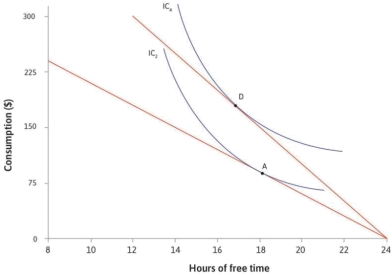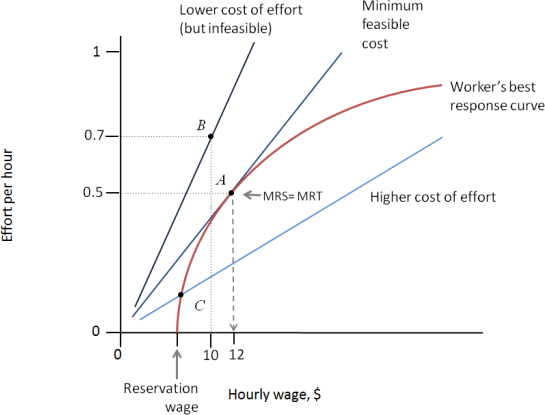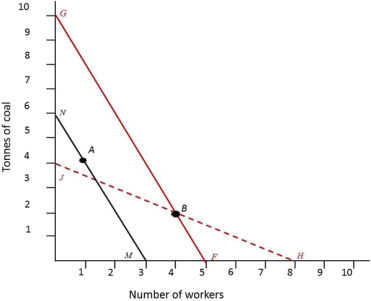Answers and sketch explanations for Econ0002 Jan 2020 MCQ exam
Hello, dear friend, you can consult us at any time if you have any questions, add WeChat: daixieit
Answers and sketch explanations for Econ0002 Jan 2020 MCQ exam
1 The GDP per capita of a country has tripled every 10 years in the second half of the last century. You are asked to draw a graph with years on the horizontal axis and GDP per capita on the vertical axis for the last century.
a) A linear scale graph will be an upward-sloping curve with decreasing slope (a concave shape).
EXPLANATION: it has increasing slope b) A logarithmic scale graph will be increasing and convex (it will have an increasing slope) in the second half ofthe century.
EXPLANATION: it is linear
c) Whether a linear scale graph is globally convex depends on what happened in the first fifty years of the last century.
EXPLANATION: in the last halfit is convex, but we do not know what happened in the first fifty years.
2 In the following graph, in the decision to go from A to D
a) The income effect in consumption is necessarily negative.
EXPLANATION: since the substitution effect is negative, the income effect could be negative or positive.
b) The absolute price of consumption may have increased. EXPLANATION: Yes, as the wage may have increased even more.
c) Now, suppose a gift in cash is given of $30 that affects both budget lines in the figure. That would make both budget constraints flatter, with the intercept on the vertical axis increasing to $260.
EXPLANATION: A gift cannot change the slope of the budget line, it only depends on relative prices.

3. Suppose the utility function of an individual is given by: U(x,y) = x + 2 ln y. Given this,
which of the following is/are true?
a) The MRS between y and x is equal to y/2.
EXPLANATION: MgUx = 1 and MgUy = 2/y
b) The consumption of y is independent of income so long as income is at least twice the relative price ![]()
![]() /
/![]()
![]() .
.
EXPLANATION: optimal choice of y is 2![]()
![]() /
/![]()
![]() ifthat is feasible.
ifthat is feasible.
c) The consumption of x is independent of income so long as income is at least
![]()
![]() /(2
/(2![]()
![]() ).
).
EXPLANATION: optimal choice of y is ![]() − (2
− (2![]()
![]() /
/![]()
![]() ) ifthat is feasible.
) ifthat is feasible.
4 Four students are deciding whether or not to contribute to their FYC project (it is a zero/one decision, either they contribute or they do not, there are no other options). For each student, the cost of contributing to the project is 5 utils. But for each student who contributes, all four of them will benefit from an increase in their training and the appreciation by their teacher of the work, so they will each gain 3 utils.
a) If a student is selfish, but others are altruistic, she has a dominant strategy to contribute.
EXPLANATION: if a student is selfish, she has a dominant strategy not to contribute. The preference of others is irrelevant.
b) If all students are altruistic, each has a dominant strategy to contribute.
EXPLANATION: They may all be altruistic, but not enough to make contributing dominant.
c) If a student is selfish, but others have a possibility to punish non-contributors after the FYC is done (say by not talking to her any more), then she may choose to contribute.
EXPLANATION: Altruistic punishment may induce cooperation ex ante.
5 . In the game represented in the following table, assume the numbers represent
monetary gains for two chefs (Ana's payoffs are the first entry in each pair of actions below, and her actions are shown in the rows). They are deciding on food for tonight.

a) Calamari is a dominated strategy for Ana.
EXPLANATION: Calamari is a best response for Ana ifPablo plays Calamari. b) Eggplant for both players is not a Nash equilibrium.
EXPLANATION: The unique Nash equilibrium is (Tofu, Eggplant).
c) This game has two Nash equilibria.
EXPLANATION: The unique Nash equilibrium is (Tofu, Eggplant).
6. In the graph below
a) Point E is Pareto Efficient as it is on the Pareto frontier. EXPLANATION: No. The MRS and MRT are different
b) Point D may be Pareto Efficient.
EXPLANATION: the graph is not sufficiently explicit, but there is nothing to contradict that statement.
c) Point H is a Pareto improvement over F.
EXPLANATION: Bruno consumes the same at H as at F and Angela is on a higher indifference curve at H than at F.

7. In the game between Angela and Bruno in Unit 5, let:
g= F(h) be the technical feasibility frontier,
g = m(h) be the biological survival constraint, and
g = U*(h) be the indifference curve going through Angela's reservation utility.
Bushels of grain are denoted by g; hours of Angela's free time are denoted by h.
a) IfBruno owns the land but is not a slaveowner, and he is selfish, he maximizes F(h) - U*(h).
EXPLANATION: A selfish Bruno (non-slaver) maximizes indeed F(h) - U*(h). b) If Bruno owns the land but is not a slaveowner, and if the government can establish a maximum length to the work week, the outcome will be both Pareto efficient and fairer.
EXPLANATION: The intervention of the government can make the outcome fairer, but as we saw in the text, it can also become Pareto inefficient.
c) The outcome ifBruno is a slave-owner who only cares about his welfare is Pareto efficient.
EXPLANATION: Bruno gets his maximal feasible utility this way, so any change would lower his utility.
8. Consider a firm with fixed costs of production. Which of the following statements about its average cost (AC) and marginal cost (MC) is correct?
a) When AC = MC, the AC curve has a zero slope.
EXPLANATION: when AC =MC the AC is minimized and then it has zero slope.
b) When AC > MC, the MC curve is downward-sloping.
![]() EXPLANATION: When AC > MC, the AC curve is downward-sloping, the MC can be upward sloping. c) The MC cannot be horizontal.
EXPLANATION: When AC > MC, the AC curve is downward-sloping, the MC can be upward sloping. c) The MC cannot be horizontal.
EXPLANATION: yes it can, it only means MC is constant, something in fact quite common.
9. If a monopolistic company faces a demand of ![]() = 20 − 1
= 20 − 1 ![]() , and the cost of
, and the cost of
production is 2![]() 2 , which of the following statements is/are true?
2 , which of the following statements is/are true?
a) Marginal revenue is 20 - 2Q. EXPLANATION: revenue is 40 – 4Q
b) The marginal cost is not increasing. EXPLANATION: Marginal cost is 2Q, thus increasing.
c) The optimal price for the firm is 5.
EXPLANATION: 40 - 4Q = 4Q, so optimal quantity is 5, and price is 30
10 In a particular perfectly competitive market, the equilibrium output and price is at (Q*, P*) = (5, €30). Suppose that the government decrees that companies must sell at a price no higher than €15.
a) The consumer surplus definitely increases.
EXPLANATION: it is not necessarily true. Prices go down, but quantity also goes down.
b) The producer surplus definitely decreases.
EXPLANATION: both prices and quantities decrease which hurt producers c) The total surplus is lower than at the market equilibrium.
EXPLANATION: as one can easily see graphically, the new equilibrium has lower total surplus.
11 Suppose that a perfectly competitive market is in equilibrium, and marginal costs are constant for all firms and equal to 4. If demand is ![]() = 20 −
= 20 − ![]()
![]() , and there is a shock for which quantity doubles for every price, then:
, and there is a shock for which quantity doubles for every price, then:
a) The demand is now Q=20-P.
EXPLANATION: Demand is now Q = 40 - P
b) The equilibrium price will double as well.
EXPLANATION: Demand is now Q = 40 – P, Supply is perfectly elastic at P=4
in both case. So new equilibrium is Q = 36, and the old equilibrium Q = 18.
c) The elasticity will double for every (Q,P) combination on the demand curve from the first demand curve to the new demand curve.
EXPLANATION: Elasticity is now P/Q and it was P/(2Q) before
12 The following is true about asset markets
a) When positive feedback occurs, the market is quickly restored to equilibrium.
EXPLANATION: Positive feedback is defined in the text as “A process whereby some initial change sets in motion a process that magnifies the initial change.” It does amplify changes, so it does not lead quickly to a new equilibrium, rather the opposite.
b) Shorting is used to benefit from a price fall.
EXPLANATION: Shorting allows a trader to benefit by selling borrowed shares while the price is high, and buying them back (to return to the owner) when the price has fallen.
c) The maximum loss a trader can incur by shorting is the price he receives from the sale ofthe shares.
EXPLANATION: The maximum loss is the difference between the prices ofthe shares at the time of sale and at the time of buying them, thus it is in principle unbounded.
13. Suppose that a firm sets the wage in the labour market and the workers’ best- response function (as shown in the figure below) shifts to the left because of a decrease in unemployment benefit. Which of the following must be true in the new equilibrium?

a) the hourly wage will fall.
EXPLANATION: New BRF will have tangency with say the isocost closest to y-axis, which clearly has lower wages
b) the effort will rise.
EXPLANATION: may or may not be true, depending on curvature of BRF, how far it moves etc
c) the firm's profits will rise.
EXPLANATION: New tangency will be on an isocost closer to the y-axis, so e/w higher, so profits higher
14. In the following diagram you are given two technologies, A and B, which can produce 500 metres of cloth. Technology A uses 1 worker and 4 tonnes of coal, while technology B uses 4 workers and 2 tonnes of coal. The diagram also depicts three examples of isocosts, NM, GF and JH. The wage cost and the price of coal are denoted by w and p, respectively. In period 1, the wage cost and the price of coal are (w, p) = (20, 40). In period 2, the wage cost and the price of coal change to (w, p) = (40, 20). The price of the cloth is 5 per metre in both periods. Which of the following statements is/are correct?

a) Technology A would be chosen in period 1 while technology B would be chosen in period 2.
EXPLANATION: Technology B would be chosen in period 1 while technology A would be chosen in period 2.
b) There is a positive economic rent in switching from technology B to A in period 2.
EXPLANATION: The economic rent is the change in profit from using technology A instead of B. After the costs change, this change in profit is ($2500 – $120) – ($2500 – $180) = $60.
c) The first firm to adopt technology A in period 2 is called an entrepreneur.
EXPLANATION: By definition.
15. Bob is a furniture maker who uses machines that generate noise and vibration. Stephen is a doctor next door whose consulting room is on the boundary ofBob’s property and so is affected by the noise and vibration. The court has granted the doctor an injunction that prevents Bob from using his machinery. Based on this information, which of the following statements is/are correct?
a) Had the court instead given Bob the right to produce, the Pareto-efficient production level would be different, ceteris paribus.
EXPLANATION: The Pareto-efficient outcome is independent ofthe allocation ofthe property rights.
b) Bob’s and Stephen’s profits in the Pareto-efficient outcome are independent ofthe court’s decision.
EXPLANATION: The distribution ofincome depends on the allocation ofthe property rights. Specifically, had the court ruled in Bob’s favour, he would have been better off as Stephen would have had to pay Bob to reduce production (rather than Bob paying Stephen to be allowed to produce).
c) The court’s role was to establish the initial property rights ofthe two parties.
EXPLANATION: The court established the doctor’s right to a quiet environment.
2022-01-10